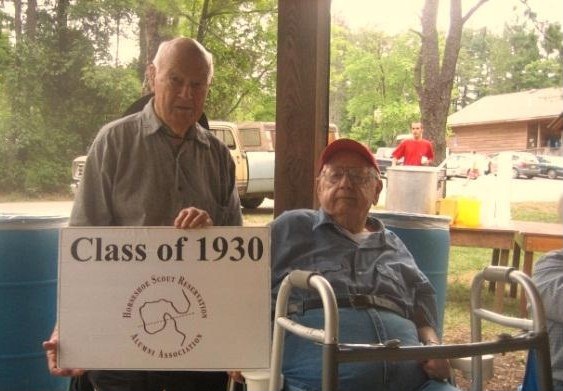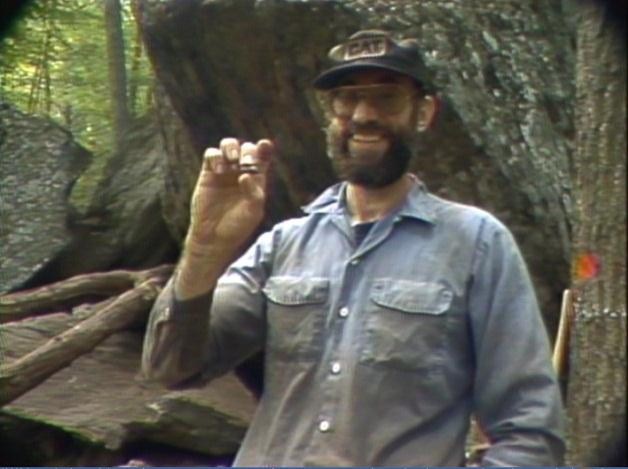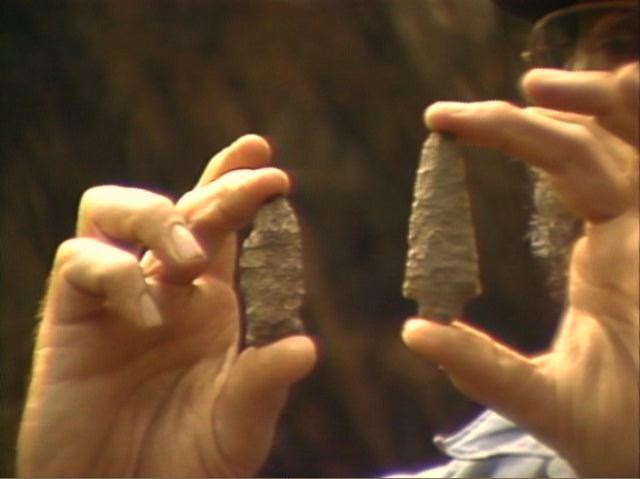2012 REUNION
From the Fall 2012 Octoraro Loop.
Another great Reunion for the Horseshoe Scout Reservation at the Goodman Pavilion!

Thanks to Damon Sinclair videos from our "ancient and honorable" film files offered those who were reuniting a chance to get a glimpse of Horseshoe's early days of the 1930's, '40's and '88. We even had a chance to see some of our present day alumni who were filmed then and wow! what has happened since? We could view Ron Sykes (Handicraft Director in the '40's) applying his skills teaching the Scouts of another day; and, Ernie Heegard in an earlier day along with Johnny Rettew atop the lifeguard stand at the pool! My how our camp changed over the years but then again so have we all. No "Oscars" but a lot of fun and laughs seeing our Scouts and staff and camp at a different time.
In 1988 a lot was going on at Horseshoe in preparation for the arrival of 1200 Polish boy and girl scouts for their "Jamboree-in-exile" (more about this at a future Reunion and issue) as well as conducting our customary great summer camp. In addition, we were "rocking" camp with a "dig" lead by Penn State University and our Archeology merit badge program that summer. Thanks to film mogul Damon Sinclair (whose current day TV filming includes those on Philadelphia's past and present); we have a great record of the Buzzards Rock "dig" that summer. All enjoyed the presentation and what it revealed about the history of that part of our camp. Also, credit goes to Rich Foote who did the sound work.
 Archaeologists from the state gave a technical name to the location ... The Horseshoe Rock Shelter which we
call Buzzards Rock. The story revealed in the video mentioned that Native American Indians were out hunting
looking for game and apparently stopped to use it for an overnight camping ground, mainly, because the rock
formation provided weather cover. These Native Americans used it for around 15,000 years; and, of course,
our Horseshoe Boy Scouts used it for around 85 years.
Archaeologists from the state gave a technical name to the location ... The Horseshoe Rock Shelter which we
call Buzzards Rock. The story revealed in the video mentioned that Native American Indians were out hunting
looking for game and apparently stopped to use it for an overnight camping ground, mainly, because the rock
formation provided weather cover. These Native Americans used it for around 15,000 years; and, of course,
our Horseshoe Boy Scouts used it for around 85 years.
The Penn State people found a lot of Boy Scout remains at the site and many of the prehistoric Indian remains were mixed with those of the Scouts. What they found primarily were little broken chips from projectile points off of arrows and spears and also the pieces that were found after they sharpen their knives and cutting tools. Findings for the period between 1700 and 1730 included projectile point or arrowheads made of steel or copper. The archeologist believes these items were most likely made by the Susquehanna Indians who lived in this area made a metal arrowhead they would trade for from the Europeans. Indians would trade beaver pelts that were used for hats and for robes that were very popular at the time. For the metal items, things that look like Dutch ovens basically as well as hoes and axes were found.
As for that prehistoric period prior to Columbus' discovery of America, one of the projectile points was made of a rock made of Pennsylvania Jasper, which the Indians would have had to travel up to or trade with the Indians near Veracruz, Pennsylvania. That one that they found is a complete artifact that is very unusual find. The archeologist felt that perhaps it could've fallen down a crack in some rocks and couldn't be retrieved; therefore, the hunting party left it behind.
One of the more unusual things found was a piece of pottery that dated back to about 1200AD. It was a part of the rim of the top of a jar that probably was broken and then the pieces were left behind.
 The spear points they found made of Quartz and Argillite, a stone found in Bucks County, indicates that
again our natives would have had traded with the Native Americans from there to get that stone or
perhaps traveled there ... a large complete point was found by our Boy Scouts... Clark Green, past Camp
Director, used it to pique the interest of the archaeology department of the State Museum of Pennsylvania.
And, thus they came and spent 6 weeks at Camp Horseshoe to do the dig.
The spear points they found made of Quartz and Argillite, a stone found in Bucks County, indicates that
again our natives would have had traded with the Native Americans from there to get that stone or
perhaps traveled there ... a large complete point was found by our Boy Scouts... Clark Green, past Camp
Director, used it to pique the interest of the archaeology department of the State Museum of Pennsylvania.
And, thus they came and spent 6 weeks at Camp Horseshoe to do the dig.
Before clay they made pots out of soapstone or steatite around 3000 BC. Again, they found a part of a small pot that would have been used for cooking. With little grooves on it. Some more points were found about the site going to the early archaic period. Dates somewhere between 6000 BC to 8000 BC 8000 to 10,000 years ago or more. Another interesting item they found the end part of a smoking tobacco pipe. Often they would use a mixture of tobacco and other leaves which they called kninack. One of the other finds that was so exciting for them ... from the Palo period what would you describe it as either a bead or a button they would've used on their buckskin outfits again very unusual find.
They also found some projectile points or arrowheads that apparently were salted on the site some years back to increase the interest of young Boys Scouts. What raised questions were stones were not nearly hard enough and the Native Americans would never use serpentine. As Mark said "No Indian his right mind would make a projectile point out of a stone like serpentine." The Scoutmaster's name associated with this was Ernie Heegard.
(Editor JB's note: At one time (circa 1946 -48 period) I recall that there was an extensive collection of arrow and spear points as well as other artifacts found on the Horseshoe property in our camp's earlier years that resided in the Spellman White House.)
Following a great barbecue and desert, songs were enjoyed and plaudits given for the films all enjoyed. A brief business meeting concluded our Reunion.
